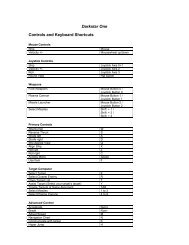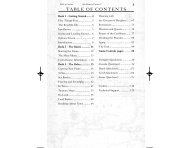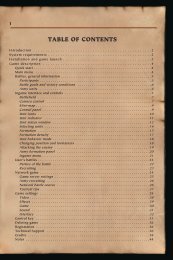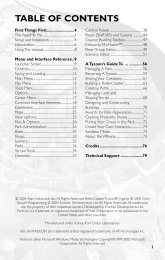Heads-Up Display Modes 35 - Metaboli
Heads-Up Display Modes 35 - Metaboli
Heads-Up Display Modes 35 - Metaboli
Create successful ePaper yourself
Turn your PDF publications into a flip-book with our unique Google optimized e-Paper software.
Sensors 69<br />
called the Pulse Repetition Frequency (PRF). Radars in “searching” modes<br />
generally use larger scan patterns and a lower PRF, letting the radar monitor<br />
multiple targets. Radars in “tracking” combine small scan areas with a high PRF.<br />
The radar then reports significantly more information about one target, and<br />
continually adjusts the scan pattern to maintain focus on the target. This is<br />
commonly called a “lock on.”<br />
Many modern radar systems attempt to bridge the gap between search and track<br />
radar modes with Track While Scan (TWS) modes. TWS modes attempt to provide<br />
detailed tracking information about multiple targets while continuing to scan a<br />
large volume of airspace. On the positive side, this provides a substantially more<br />
thorough picture of the sky. On the downside, the radar must make “educated<br />
guesses” about the tracked targets, since the radar cannot focus attention on any<br />
single target. Based on information collected when the radar beam scans a given<br />
target, the radar predicts the target’s flight path until the beam again scans that<br />
target. While the beam is busy scanning other targets, the radar display shows<br />
the predicted position of the first target. If that makes a sudden, unexpected<br />
maneuver, the radar display continues to show the predicted position until the<br />
radar beam finally returns its attention to the target and finds it gone.<br />
hTWS mode provides details for multiple targets simultaneously, but<br />
relies on estimations of the target’s position, and can therefore be<br />
“tricked” if a target makes an unexpected maneuver.<br />
4.002 Infrared<br />
Engines, especially jet engines, produce a lot of heat. Weapon designers quickly<br />
realized they could detect and track this heat, or Infrared (IR) energy. Early IR<br />
systems could only track targets from behind, with the hot engine exhaust<br />
pointed directly at the seeker. Modern all-aspect heat-seeking missiles can track<br />
the heat emitted from a target from any angle. Further, many aircraft carry Infrared<br />
Search and Track (IRST) systems, which can detect targets many miles away. IRST<br />
systems are passive, meaning they emit no energy of any kind. Unlike radar,<br />
which announces the emitter’s presence to the world, IR systems are completely<br />
“stealthy” and impossible to detect.<br />
hWeather, such as rain and fog, seriously degrades IR performance. In<br />
severe weather conditions, IR systems suffer greatly shortened<br />
detection ranges.<br />
4.003 Laser<br />
Laser systems provide modern combat aircraft with a third major sensor system.<br />
Laser rangefinders calculate distance very accurately by bouncing a laser beam off<br />
the target and measuring how long it takes the beam of laser light to return to the<br />
emitter. Ground-attack systems use lasers to pinpoint specific objects (such as an<br />
individual battle tank or a specific window on a building) to guide air-to-ground<br />
weapons. Since lasers, like radar, emit energy, laser emitters can be detected by<br />
hostile forces.<br />
As with IR systems, laser systems work best in clear weather. Clouds, fog, and<br />
rain seriously degrade laser systems.















